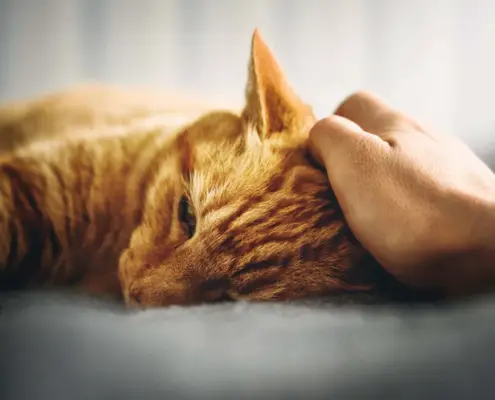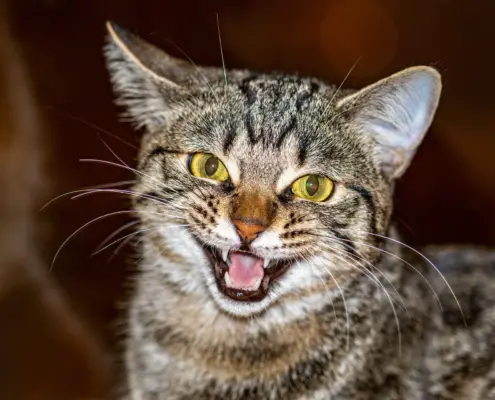
When it comes to the question of whether cats can taste sweets, the answer is a bit more complicated than a simple “yes” or “no.” While cats do possess taste buds, their taste receptors are different from those found in humans. Cats are obligate carnivores, which means their bodies are designed to thrive on a diet primarily composed of meat. As a result, their taste buds have evolved to favor the flavors and textures of meat.
Understanding a Cat’s Taste Buds
A cat’s taste buds are quite different from ours. Humans have around 10’000 taste buds, while cats only have around 470. Additionally, cats have taste receptors that are highly sensitive to amino acids, which are the building blocks of protein found in meat. This explains why cats are so attracted to the taste of meat and why they often turn their noses up at other flavors.
Cats can’t taste taste sweet flavors, making them mostly indifferent to sweet tastes. While humans have specific taste receptors for sweet flavors, cats lack these receptors. This means that cats are unable to fully appreciate the taste of sugary treats in the same way that we do.
The Role of Taste Preferences in Cats’ Diets
Cats’ taste preferences play a crucial role in their diets. As obligate carnivores, cats require a diet that is rich in high-quality animal protein. This is because their bodies have specific dietary requirements that can only be met through the consumption of meat.
The taste preferences of cats help to ensure that they seek out and consume the types of foods that are most beneficial for their health. By naturally gravitating towards meaty flavors, cats are instinctively choosing the foods that provide them with the essential nutrients they need to thrive.
Do Cats Enjoy Sweet Flavors?
While cats may not have a strong taste for sweetness, some felines may still enjoy the occasional sweet treat. This can vary from cat to cat, as individual preferences and tastes can differ. Some cats may show an interest in sweet flavors, while others may not pay them any attention at all.
It’s important to note that just because a cat enjoys the taste of something sweet doesn’t mean that it is a healthy or appropriate choice for their diet. Cats have very specific nutritional needs, and indulging them with sugary treats can lead to weight gain, dental issues, and other health problems.
Potential Risks of Giving Sweets to Cats
Feeding your cat sweets can have several potential risks and adverse effects on their health. Firstly, many sweet treats designed for humans contain ingredients that can be toxic to cats, such as chocolate or xylitol. Consuming these substances can lead to symptoms ranging from upset stomachs to life-threatening conditions.
Furthermore, feeding your cat sweets can contribute to obesity, as these treats are typically high in calories and low in nutritional value. Obesity in cats can lead to a variety of health issues, including diabetes, joint problems, and a reduced lifespan.
Alternatives to Sweets for Cat Treats
Instead of giving your cat sweets, there are plenty of alternative treats that can satisfy their taste buds without compromising their health. Look for cat-specific treats that are made with high-quality ingredients and formulated to meet their nutritional needs.
Some popular cat treats include freeze-dried meat, dehydrated fish, and even specialized dental treats that promote oral health. These options provide a flavorful and nutritious alternative to sugary sweets while still indulging your cat’s desire for something tasty.
How to Satisfy Your Cat’s Sweet Tooth in a Safe Way
If you’re determined to satisfy your cat’s sweet tooth, there are safe ways to do so. One option is to make homemade cat treats using natural ingredients that are safe for feline consumption. There are plenty of recipes available online that cater to cats’ taste preferences and nutritional needs.
Another option is to explore cat-friendly flavors that mimic sweetness without using actual sugar. For example, some cat food companies offer products with flavors like chicken and cranberry or salmon and sweet potato. These options can provide a hint of sweetness without the risks associated with feeding your cat traditional sweets.
Tips for Introducing New Flavors to Your Cat’s Diet
Introducing new flavors to your cat’s diet can be a gradual process. Cats can be finicky eaters and may need time to adjust to new tastes. Start by offering small amounts of the new flavor alongside their regular food. Over time, gradually increase the proportion of the new flavor until your cat becomes accustomed to it.
It’s also important to pay attention to any signs of digestive upset or allergic reactions when introducing new flavors. If your cat displays any adverse reactions, discontinue the new flavor and consult with a veterinarian if necessary.
The Importance of a Balanced and Species-Appropriate Diet for Cats
While cats may enjoy the occasional sweet treat, it’s essential to prioritize their overall health and nutritional needs. Cats require a balanced and species-appropriate diet that is rich in animal protein and low in carbohydrates. This ensures they receive the necessary nutrients to support their unique physiology and maintain optimal health.
Consulting with a veterinarian is crucial when selecting a diet for your cat. They can provide guidance on choosing the right type of food and treats that meet your cat’s specific needs, taking into consideration factors such as age, weight, and any underlying health conditions.
Conclusion
While cats may not have a strong taste for sweets, they can still enjoy the occasional treat in moderation. However, it’s vital to prioritize their health and nutritional needs when considering what to feed them. Opting for cat-specific treats that are made with high-quality ingredients and formulated to meet their dietary requirements is the best way to indulge your cat’s taste buds while keeping them safe and healthy. Remember, a balanced and species-appropriate diet is key to ensuring your feline companion’s long-term well-being.
If you enjoyed my article, I would appreciate you sharing it with your network.

Sima Ndlebe
Sima writes for CatBuzz. He is interested in Cats, Health and Fitness, and Entrepreneurship.
Published: 14 November 2023



